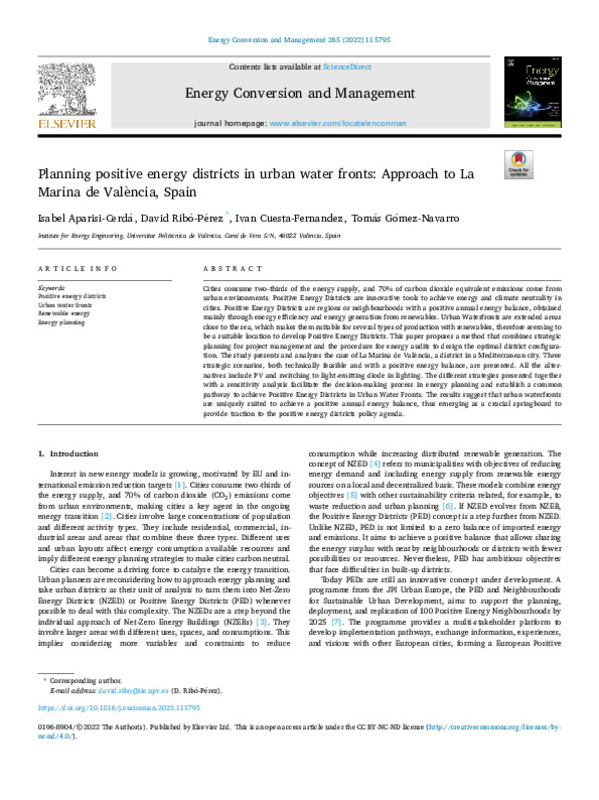JavaScript is disabled for your browser. Some features of this site may not work without it.
Buscar en RiuNet
Listar
Mi cuenta
Estadísticas
Ayuda RiuNet
Admin. UPV
Planning Positive Energy Districts in Urban Water Fronts: approach to La Marina de València, Spain
Mostrar el registro sencillo del ítem
Ficheros en el ítem
| dc.contributor.author | Aparisi-Cerdá, Isabel
|
es_ES |
| dc.contributor.author | Ribó-Pérez, David Gabriel
|
es_ES |
| dc.contributor.author | Cuesta-Fernandez, Ivan
|
es_ES |
| dc.contributor.author | Gómez-Navarro, Tomás
|
es_ES |
| dc.date.accessioned | 2022-06-10T18:06:39Z | |
| dc.date.available | 2022-06-10T18:06:39Z | |
| dc.date.issued | 2022-08-01 | es_ES |
| dc.identifier.issn | 0196-8904 | es_ES |
| dc.identifier.uri | http://hdl.handle.net/10251/183191 | |
| dc.description.abstract | [EN] Cities consume two-thirds of the energy supply, and 70% of carbon dioxide equivalent emissions come from urban environments. Positive Energy Districts are innovative tools to achieve energy and climate neutrality in cities. Positive Energy Districts are regions or neighbourhoods with a positive annual energy balance, obtained mainly through energy efficiency and energy generation from renewables. Urban Waterfronts are extended areas close to the sea, which makes them suitable for several types of production with renewables, therefore seeming to be a suitable location to develop Positive Energy Districts. This paper proposes a method that combines strategic planning for project management and the procedure for energy audits to design the optimal district configuration. The study presents and analyses the case of La Marina de València, a district in a Mediterranean city. Three strategic scenarios, both technically feasible and with a positive energy balance, are presented. All the alternatives include PV and switching to light-emitting diode in lighting. The different strategies presented together with a sensitivity analysis facilitate the decision-making process in energy planning and establish a common pathway to achieve Positive Energy Districts in Urban Water Fronts. The results suggest that urban waterfronts are uniquely suited to achieve a positive annual energy balance, thus emerging as a crucial springboard to provide traction to the positive energy districts policy agenda | es_ES |
| dc.description.sponsorship | This work was supported in part by the Spanish public administration under grant FPU2016/00962, and by the Catedra de Transicion Energética Urbana (Las Naves-Fundació València Clima i Energía-UPV) | es_ES |
| dc.language | Inglés | es_ES |
| dc.publisher | Elsevier | es_ES |
| dc.relation.ispartof | Energy Conversion and Management | es_ES |
| dc.rights | Reconocimiento - No comercial - Sin obra derivada (by-nc-nd) | es_ES |
| dc.subject | Positive Energy Districts | es_ES |
| dc.subject | Urban Water Fronts | es_ES |
| dc.subject | Renewable Energy | es_ES |
| dc.subject | Energy Planning | es_ES |
| dc.subject.classification | INGENIERIA ELECTRICA | es_ES |
| dc.subject.classification | PROYECTOS DE INGENIERIA | es_ES |
| dc.title | Planning Positive Energy Districts in Urban Water Fronts: approach to La Marina de València, Spain | es_ES |
| dc.type | Artículo | es_ES |
| dc.identifier.doi | 10.1016/j.enconman.2022.115795 | es_ES |
| dc.relation.projectID | info:eu-repo/grantAgreement/EC/H2020/730283/EU | es_ES |
| dc.relation.projectID | info:eu-repo/grantAgreement/Cátedra de Transición Energética Urbana, Universitat Politècnica de València//FPU2016%2F00962/ | es_ES |
| dc.relation.projectID | info:eu-repo/grantAgreement/EC/H2020/837854/EU | es_ES |
| dc.relation.projectID | info:eu-repo/grantAgreement/ASSOCIATION CLIMATE KIC//TC2018A_2.1.5-PRO_P066-1B//PROSUME: ENABLING PROSUMERS SERVICES/ | es_ES |
| dc.rights.accessRights | Abierto | es_ES |
| dc.contributor.affiliation | Universitat Politècnica de València. Departamento de Proyectos de Ingeniería - Departament de Projectes d'Enginyeria | es_ES |
| dc.description.bibliographicCitation | Aparisi-Cerdá, I.; Ribó-Pérez, DG.; Cuesta-Fernandez, I.; Gómez-Navarro, T. (2022). Planning Positive Energy Districts in Urban Water Fronts: approach to La Marina de València, Spain. Energy Conversion and Management. 265:1-14. https://doi.org/10.1016/j.enconman.2022.115795 | es_ES |
| dc.description.accrualMethod | S | es_ES |
| dc.relation.publisherversion | https://doi.org/10.1016/j.enconman.2022.115795 | es_ES |
| dc.description.upvformatpinicio | 1 | es_ES |
| dc.description.upvformatpfin | 14 | es_ES |
| dc.type.version | info:eu-repo/semantics/publishedVersion | es_ES |
| dc.description.volume | 265 | es_ES |
| dc.relation.pasarela | S\465504 | es_ES |
| dc.contributor.funder | ASSOCIATION CLIMATE KIC | es_ES |
| dc.contributor.funder | COMISION DE LAS COMUNIDADES EUROPEA | es_ES |
| dc.contributor.funder | Cátedra de Transición Energética Urbana, Universitat Politècnica de València | es_ES |
| dc.contributor.funder | Universitat Politècnica de València | es_ES |
| dc.subject.ods | 07.- Asegurar el acceso a energías asequibles, fiables, sostenibles y modernas para todos | es_ES |
| dc.subject.ods | 11.- Conseguir que las ciudades y los asentamientos humanos sean inclusivos, seguros, resilientes y sostenibles | es_ES |
| dc.subject.ods | 13.- Tomar medidas urgentes para combatir el cambio climático y sus efectos | es_ES |








